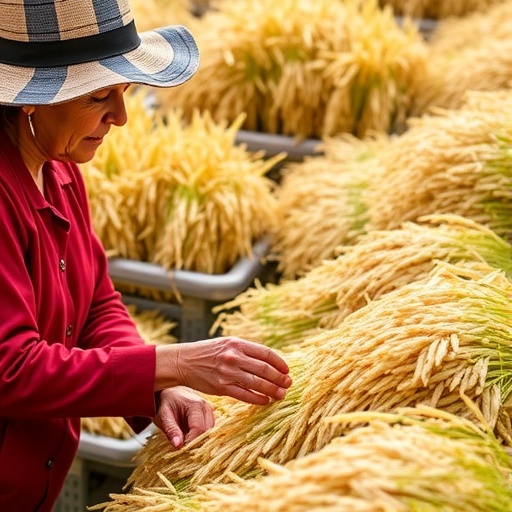Recent research has illuminated the complexities and evolving dynamics surrounding the study of aromatic rice, a crop with an immense cultural and economic impact across various regions, particularly in Asia. The work conducted by Shahidullah, Shirazy, and Quais provides an expansive bibliometric analysis that not only sheds light on the existing body of knowledge but also paves the way for future investigations in the field. The paper meticulously examines various publication trends that reflect the growth of interest in aromatic rice research, an area often overshadowed by more mainstream agricultural studies.
Aromatic rice varieties, such as Basmati and Jasmine, are renowned for their distinctive flavors and fragrances, making them highly sought after in culinary sectors around the globe. The study emphasizes the importance of aromatic rice not only for its sensory attributes but also for its economic value in local and international markets. As globalization continues to influence agricultural practices, understanding the research landscape surrounding aromatic rice becomes critical for stakeholders aiming to harness its potential.
The bibliometric insights provided in the research are instrumental in identifying key contributors and institutions leading the charge in aromatic rice studies. It has become evident that certain regions are hotbeds for such research activity, notably South Asia, which hosts a rich biodiversity of aromatic rice varieties. This geographical concentration signifies the need for collaborative efforts among researchers to synthesize knowledge and foster innovations that can enhance agricultural practices.
Technically, the paper employs advanced bibliometric methodologies to analyze publication metrics such as citation counts, impact factors, and keyword co-occurrences. This quantitative approach provides a comprehensive view of how research in aromatic rice has evolved over time. The citation analysis highlights which studies have made significant contributions and have been recognized within the scientific community, thereby outlining the foundational works that future research can build upon.
As the research community shifts its focus towards sustainable agricultural practices, aromatic rice is positioned as a promising candidate for further exploration. The authors suggest that the future of research should not only revolve around improving yield but also around sustainability, flavor enhancement, and pest resistance. Given the increasing impacts of climate change and the pressing need for food security, the integration of innovative agricultural technologies could be vital. This positions aromatic rice as a suitable candidate for emerging environmentally friendly agricultural strategies.
Emerging trends identified in the study point toward the utilization of molecular techniques in defining the genetic characteristics of aromatic rice. With the advent of genomic technologies, researchers are now equipped to delve deeper into the genetic makeup of these varieties, which could lead to the development of improved cultivars. Such advancements hold promise in enhancing not only the aromatic qualities but also the resilience of rice against climate pressures.
Furthermore, the bibliometric analysis revealed an uptick in interdisciplinary research, highlighting collaborations between agricultural scientists, sensory analysts, and economists. This interconnectedness illustrates a growing recognition of the multifaceted benefits of aromatic rice, extending beyond simple agronomy to encapsulate aspects of health, nutrition, and socio-economic development. The authors advocate for a multi-disciplinary approach in future studies to fully exploit the potential of aromatic rice in addressing global challenges.
The issue of intellectual property rights in the context of aromatic rice research also garners attention in the paper. With the commercialization of aromatic rice varieties, the intertwining of trade and agricultural research presents both opportunities and challenges. As researchers continue to uncover the potentials of these unique varieties, the ethical considerations surrounding the ownership and use of traditional knowledge must not be overlooked.
Policy implications also arise from the findings of this study. The authors highlight the necessity for tailored policies that support aromatic rice cultivation while ensuring the sustainable use of resources and fair compensation for local farmers. Such policies will play a crucial role in advancing research agendas that prioritize the interests of rural communities dependent on aromatic rice economies.
In addition to these findings, the study calls for increased transparency and accessibility of research data in the field. With the rapid pace of scientific advancement, making data openly available can facilitate collaborative efforts that accelerate innovations and solutions for pressing agricultural issues. This call for data transparency resonates with the broader movement towards open science, encouraging researchers globally to contribute to the collective knowledge pool regarding aromatic rice.
As the research continues to evolve, the authors envision a future where aromatic rice not only enhances culinary experiences but also plays a critical role in sustainable food systems. The prospects of innovative breeding programs, ethical agricultural practices, and community engagement present a comprehensive roadmap for future research.
In conclusion, the work of Shahidullah, Shirazy, and Quais serves as a clarion call to the global research community to delve deeper into the intricate world of aromatic rice. The bibliometric insights provided offer valuable direction for future inquiries while emphasizing the significant cultural, economic, and environmental importance of this unique crop. Researchers are now tasked with translating these insights into actionable strategies that could lead to transformative advancements in the cultivation and utilization of aromatic rice.
With its rich flavors and potential contributions to sustainable agriculture, the future of aromatic rice research holds a promise that transcends traditional boundaries, engaging an array of stakeholders from scholars to policymakers. As this field continues to flourish, it remains a testament to the power of agricultural innovation in crafting solutions that are both sustainable and culturally enriching.
Subject of Research: Aromatic Rice Research Dynamics
Article Title: Unveiling global research dynamics in aromatic rice: bibliometric insights and future directions
Article References:
Shahidullah, S.M., Shirazy, B.J., Quais, M.K. et al. Unveiling global research dynamics in aromatic rice: bibliometric insights and future directions.
Discov. Plants 2, 261 (2025). https://doi.org/10.1007/s44372-025-00348-4
Image Credits: AI Generated
DOI: 10.1007/s44372-025-00348-4
Keywords: Aromatic rice, bibliometrics, agricultural research, sustainability, molecular techniques.




